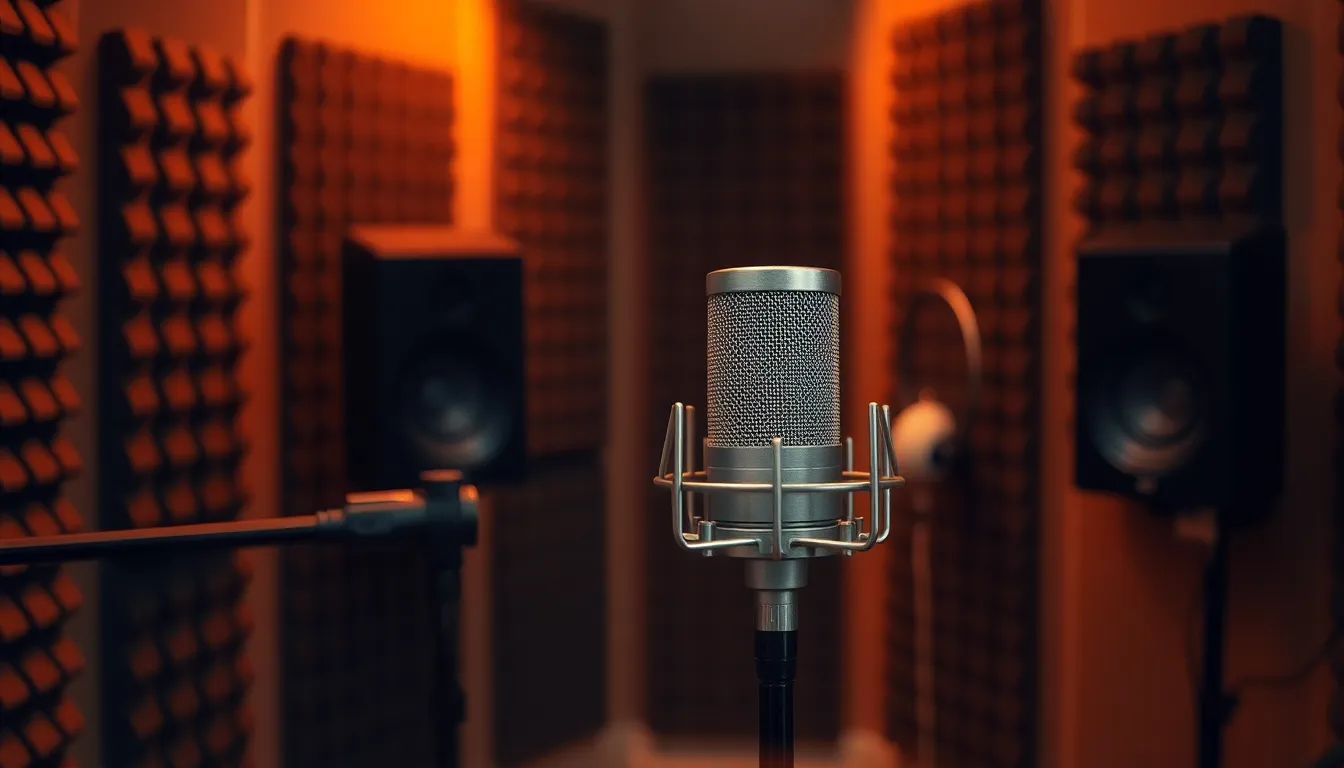When it comes to capturing sound, mic placement can make or break the recording. Imagine your favorite band’s hit song, but instead of crisp vocals and punchy instrumentals, all you hear is a muffled mess. It’s enough to make anyone cringe. Proper mic placement isn’t just a technical skill; it’s an art that can elevate any audio project from mediocre to magnificent.
Table of Contents
ToggleOverview of Mic Placement Techniques
Mic placement techniques play a vital role in audio recording, directly affecting sound quality. Understanding the various approaches helps in achieving desired results.
Distance from the sound source significantly influences audio capture. Placing microphones too close can lead to excessive bass, known as the proximity effect. Conversely, positioning them too far can cause loss of clarity and presence.
Angle matters as well. Proper angling can reduce unwanted reflections and background noise. For instance, aiming the mic slightly off-axis from the sound source often yields a more balanced sound.
Type of microphone also dictates placement strategy. Dynamic microphones typically require closer placement due to their lower sensitivity, while condenser microphones can perform well at further distances due to their high sensitivity and capture range.
Room acoustics can’t be overlooked. Recording in spaces with heavy furnishings might enhance sound quality by absorbing echoes, whereas empty rooms might reflect sound, creating challenges in mic placement.
Using specific techniques can optimize results further. The spaced pair technique involves placing two mics at equal distances from the sound source, enhancing stereo imaging. The coincident pair technique involves two mics positioned at the same point, capturing a more cohesive sound.
Experimentation remains key. Adjusting mic placement based on instruments, vocalists, and environment leads to improved recordings. Trying different positions can uncover unique sounds, enhancing the overall audio experience.
Each mic placement technique offers unique benefits and challenges. Mastering these techniques contributes to exceptional audio quality and professionalism in recording projects.
Importance of Proper Mic Placement

Proper mic placement greatly influences audio quality. Achieving the right positioning can enhance clarity, presence, and overall sound depth.
Impact on Sound Quality
Sound quality heavily relies on the positioning of the microphone. Appropriate distances minimize bass distortion while maximizing clarity. For instance, a condenser microphone positioned further away captures ambient nuances, creating a fuller sound. Dynamic microphones, in contrast, thrive on closer placement, allowing for detailed vocal articulation. Incorrect angles may introduce unwanted reflections, muddying the audio. Each recording situation demands careful adjustment to balance direct sound and room acoustics, ensuring recordings are vibrant and professional.
Common Mistakes to Avoid
Ignoring distance often leads to common audio pitfalls. Placing microphones too near a sound source can create excessive low-frequency response, resulting in a booming effect. Not considering mic type when choosing a placement strategy can also hinder recording quality. Likewise, neglecting room acoustics often leaves audio recordings flat and lifeless. Adjusting angles to reduce reflective surfaces is crucial, yet many forget this step. Lastly, underestimating the need to experiment can stifle creativity and outcomes. Staying aware of these mistakes fosters better recording practices and superior audio results.
Types of Mic Placement Techniques
Microphone placement techniques vary and can significantly influence sound quality. Different approaches cater to varying audio projects, environments, and desired outcomes.
Close Miking
Close miking involves positioning the microphone within a few inches of the sound source. This technique captures vibrant sound while minimizing background noise. Musicians and sound engineers often use close miking for vocals and instruments to achieve clarity. Capturing intimate details, this method emphasizes the nuances of performance. It’s particularly effective for instruments like electric guitars and snare drums. Close miking can enhance the direct sound, making it prominent in recordings.
Ambient Miking
Ambient miking focuses on capturing the overall sound of a space. This technique often places microphones further from sound sources to incorporate room reflections. Utilizing ambient miking creates a sense of depth and atmosphere in recordings. This approach works well for orchestral music or live band performances, where room acoustics contribute to the sonic character. Ambient miking can balance clarity and warmth, allowing for a natural blend of sounds. Recognizing the room’s nature while applying this technique is essential for optimal results.
Stereo Miking Techniques
Stereo miking encompasses various methods to create a wider sound field. Techniques like the XY configuration involve placing two microphones close together at an angle. This setup captures a balanced stereo image, preserving phase coherence. Another popular method, the AB technique, positions mics further apart to emphasize spatial separation. Utilizing these techniques can enhance listening experiences, making them ideal for recordings that require immersive sound. Practicing stereo miking adds richness and dimension to audio projects, fostering a more engaging auditory experience.
Tips for Effective Mic Placement
Effective mic placement requires continuous experimentation and adjustment. Moving a microphone just a few inches can change the sound drastically. Testing different distances allows for finding the sweet spot that captures the best quality. Adjusting angles can also aid in managing unwanted reflections and background noise. Specific instruments or vocal styles may require different settings, so tweaking placement based on the performance context becomes essential.
Understanding the acoustic environment enhances mic placement techniques. Each room carries unique characteristics that affect sound quality. Hard surfaces can create reflections, while softer materials tend to absorb sound. Assessing the environment beforehand lets you tailor mic positioning for optimal results. Identifying where sound reflects and where it absorbs will aid in deciding mic distances and angles. Room size and shape impact reverberation times, which should influence placement decisions.
Mastering mic placement techniques is essential for anyone serious about audio recording. By understanding the nuances of distance angle and room acoustics, one can significantly enhance sound quality. Experimentation remains key as even slight adjustments can yield remarkable differences in recordings.
Recognizing the unique characteristics of each environment helps tailor mic positioning for optimal results. Avoiding common mistakes and continuously refining techniques will lead to more professional audio outcomes. Embracing the art of mic placement not only elevates the recording process but also transforms the overall listening experience.




